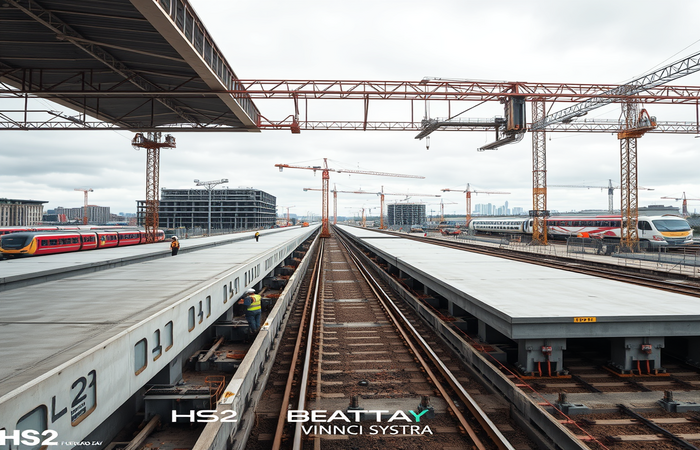Lisbon’s Cascais Line: Modern Rail Tech Upgrade

This article examines the modernization of the Cascais Line’s railway infrastructure in Lisbon, Portugal, focusing on the significant upgrade of its telecommunications and passenger information systems by Hitachi Rail. The project encompasses a multifaceted approach, incorporating not only improved passenger communication but also advancements in operational efficiency and safety through the implementation of cutting-edge technology. This modernization, a testament to the evolving landscape of railway technology, demonstrates the increasing reliance on sophisticated digital systems to enhance both the passenger experience and the overall operational efficacy of railway networks. The implications of this project extend beyond the Cascais Line, offering insights into broader trends in railway infrastructure development and the crucial role of technological integration in modern rail transportation. The scope of this modernization extends from enhancing real-time information dissemination to optimizing operational control and energy management, all contributing to a safer, more efficient, and more passenger-friendly railway experience.
Modernizing Passenger Information Systems
Hitachi Rail, in collaboration with Portuguese firms SISINT and Conecticabo, is implementing a fully automated Passenger Information System (PIS) across all Cascais Line stations. This system will provide real-time updates on train schedules, delays, and any disruptions, improving communication transparency and passenger satisfaction. The new system’s multimedia capabilities pave the way for future innovations in passenger communication, anticipating evolving needs and technological advancements within the rail industry. This represents a move beyond simple text-based announcements to a more dynamic and engaging passenger experience.
Overhauling Telematics and SCADA Systems
Beyond passenger information, Hitachi Rail is comprehensively overhauling the Cascais Line’s telematics systems. This project involves upgrading the data network infrastructure, improving time synchronization across the system, implementing more efficient energy management strategies, and modernizing the Supervisory Control and Data Acquisition (SCADA) systems. SCADA systems are crucial for real-time monitoring and control of various aspects of railway operations, from track conditions to train positioning. This upgrade promises improved operational efficiency, optimized resource allocation, and enhanced safety measures throughout the line.
Leveraging Hitachi Rail’s Expertise and Partnerships
Hitachi Rail’s long-standing presence in the Portuguese rail sector, dating back to the early 1990s, underpins its expertise in this project. Their contributions include the introduction of European Train Control System (ETCS) Level 2 signaling, initially on international lines and subsequently on the Cascais Line. This experience, combined with collaborations with local companies like SISINT and Conecticabo, leverages both international best practices and localized knowledge to ensure a successful and sustainable modernization. This collaborative approach fosters technology transfer and strengthens the local rail industry’s capacity.
Broader Implications for Railway Infrastructure
The Cascais Line modernization project serves as a case study for broader trends in railway infrastructure development. The integration of advanced telecommunications, sophisticated PIS, and modernized SCADA systems points towards a future where railway networks are more data-driven, automated, and responsive to passenger needs. The project highlights the increasing importance of Intelligent Transportation Systems (ITS) in enhancing efficiency, safety, and the overall passenger experience. The successful implementation of this project on the Cascais Line can serve as a model for similar modernization efforts on other railway lines in Portugal and globally.
Conclusions
The modernization of the Cascais Line’s telecommunications and passenger information systems by Hitachi Rail represents a significant advancement in Portuguese railway infrastructure. The project, encompassing the implementation of a fully automated Passenger Information System (PIS) and an overhaul of the line’s telematics and Supervisory Control and Data Acquisition (SCADA) systems, showcases the transformative potential of integrating advanced technologies into railway operations. The collaboration between Hitachi Rail and Portuguese companies SISINT and Conecticabo underscores the value of partnerships in leveraging both international expertise and local knowledge. The upgraded systems will not only enhance the passenger experience through real-time information and seamless communication but also improve operational efficiency, energy management, and overall safety. This modernization exemplifies a broader trend in the rail industry toward data-driven operations and the increasing importance of Intelligent Transportation Systems (ITS). The success of this project on the Cascais Line holds valuable lessons for similar modernization efforts worldwide, emphasizing the crucial role of technological advancements in creating safer, more efficient, and more passenger-centric railway networks. The focus on real-time data, improved communication, and streamlined operational control signals a future where railway systems are not only more advanced technologically but also more responsive to the needs of both passengers and operators. The Cascais Line serves as a powerful example of how investment in modern infrastructure can lead to significant improvements in the overall quality and efficiency of rail transportation.





